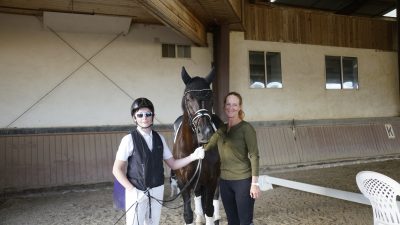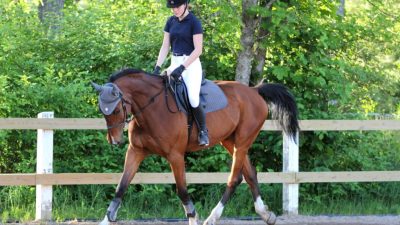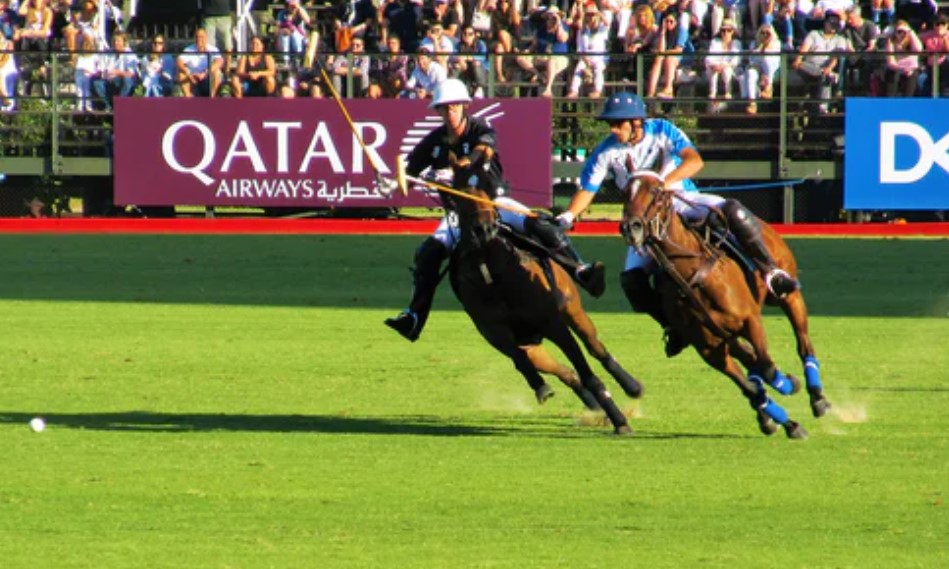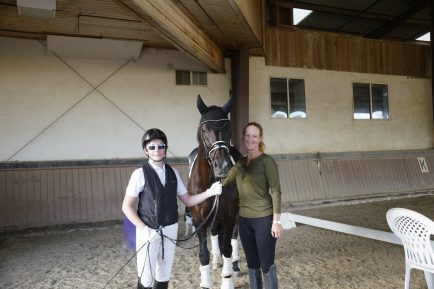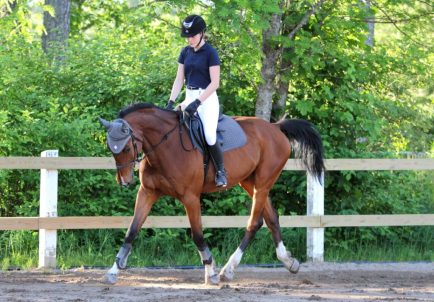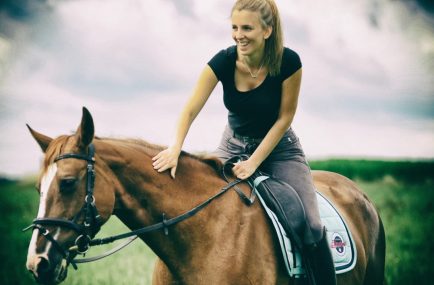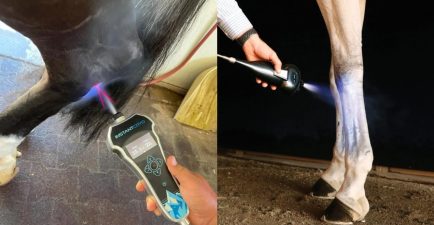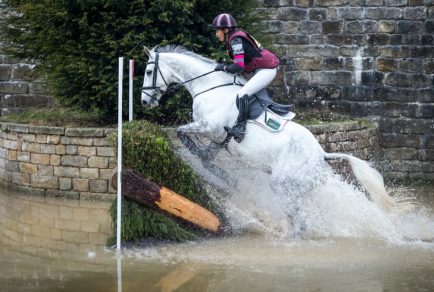Over a 25 year span, I’ve had more than my fair share of riding accidents and subsequent injuries. I’ve broken both collarbones twice and had five corresponding surgeries. I’ve also had torn muscles, concussions, broken fingers and a lot of other bumps and bruises along the way. The truth is riding is a dangerous sport and every time we swing a leg over a horse, we need to accept that we are taking a certain risk. As the legendary George Morris says, “When it bites, it bites hard.” If you spend enough time with horses, eventually you’re going to have a fall. A good instructor will hopefully prevent a lot of falls by matching you with a horse that you’re capable of riding and not asking you to do something that is above your skill level or potentially dangerous. No matter what, always wear a helmet when you get on a horse. This can prevent the most serious of injuries.
Through my accidents, injuries, recoveries and setbacks, I’ve come to a few conclusions about how to overcome injuries and properly ease back into riding. Here are five tips to cope and prevail.
1. Lean on Your Support System
My worst injury was the first time I broke my collarbone. It was particularly bad because I didn’t just have a broken clavicle; I also had torn muscles in my upper body and my face was really beat up. It took two months before I was able to get back in the saddle. During this time, it was so important for me to have a support system in place to get me through the initial recovery. And it was just for little things—like someone to bring me ice or help me get out of bed until I could get back on my feet and do some things for myself. It was also important to have people oversee the care of my horses and manage daily tasks at the barn. I had great assistants who stepped up and took over for me until I was well enough to start managing and teaching again.
2. Focus on the Positive
If you are injured in a riding accident, do your best not to dwell on the bad experience as this will lead to confidence issues. Try to stay positive and learn from the accident. Ask yourself, Why did it happen? How could I’ve prevented it?
One way I was able to stay positive and motivated was by researching top riders in the sport who have encountered something similar. I read books or went to YouTube to watch videos. I particularly enjoyed a book called “Unbridled Passion: Show Jumping’s Greatest Horses and Riders” by Jeff Papows. I discovered that there were other riders who had to deal with lots of different injuries, and I came to the realization that I wasn’t alone in that. Riders I looked up to at the highest level of the sport have also faced the same challenges I did. Two-time Olympic gold medalist McLain Ward broke his collarbone. Seven-time Olympian Nick Skelton broke his neck. Top British show jumper Tim Stockdale (who passed away last November) broke his neck, was in a full body cast for about 6 weeks and bounced back to the top level of the sport.
I also found that working on physical therapy was encouraging. It was something I could focus on that helped me move in the direction of being completely sound and healthy again. As I started to get stronger, my progress kept me motivated and excited to keep working.
I am a very active person. With some of my injuries I was able to do some sort of exercise that was beneficial to maintain a base fitness level while also keeping myself in an optimistic mental state. When I had the broken collarbones I was able to do a lot of stationary biking. That was my go-to workout as it was comfortable to perform and I could work up a good sweat. I even went to the rock climbing gym and did some easy climbing one-handed. When I tore my groin, I still did a lot of stretching, some upper-body weight training and swimming—and then would soak in the hot tub afterward. Just because one body part is injured doesn’t necessarily mean you can’t work other muscle groups. Of course, every individual and situation is different so you’ll want to check with your doctor or physical therapist on what your limitations are and what exercises you may be able to continue.
3. Ease Back Into It
After I broke my collarbone the first time, I was so enthusiastic to get back in the saddle. I had been out for a couple of months, and I wanted to get right back to where I left off and put in 110 percent effort. I ended up doing too much, too fast and tore my groin which added a couple more months to my recovery and a lot more stress. Be smart and listen to your body.
Physically, you want to make sure you don’t overdo it too quickly, but you also want to make sure you aren’t overfaced mentally, especially if there’s some residual fear from a fall. When I started to ride again, initially there was some physical fear that had developed and that’s completely normal. George Morris says there’s two types of fear—there’s physical fear and mental fear. Physical fear is learned and can come from riding accidents. Mental fear is nerves, or the fear of making a mistake.
If you are fearful to get back in the saddle, start slowly and build up in small increments with each session. Eventually you will start to trust yourself and your horse. If you do too much, too fast, you could scare yourself and be forced to take a step back. It’s better to go even slower than you think you need to and build gradually. For example, it could be as simple as quietly mounting a horse and walking around for a few minutes before calling it quits for the day. It’s also important to focus on positive self-talk. If any thoughts of fear start creeping into your mind, try to stop them and focus on the positive while staying relaxed.
4. Improve Fitness to Prevent Injuries
You will be less likely to sustain an injury while being physically active if you have a good level of fitness because your body is overall stronger. Riders should be athletes, take their physical fitness seriously and spend some time a few days a week doing some type of exercise. I’m very much into cross-training. I like to surf, hike and go to the rock-climbing gym. Going to the gym—lifting weights, running on the treadmill, using the Stairmaster—is a great workout, but there are also so many other activities that can improve fitness. The key is to find something you like so you will stay motivated to keep going back.
5. Manage Old Injuries
Old injuries can flare up. I’m a big believer in icing. My horses all get iced after a vigorous jumping, so I apply the same rules to my injuries. If any old injury is acting up a bit, I’ll ice it at the end of the day or after a ride. I also occasionally take ibuprofen (follow the dosage instructions on the bottle) to help with inflammation. Stretching is also important, especially with a soft-tissue injury. Do some light stretching before you start riding for the day and then again afterward. Unfortunately, sometimes you do have to work through the pain, which I learned from my doctors and physical therapists.
Original article: How to Overcome Riding Injuries (practicalhorsemanmag.com)
www.royalequestriancollection.com – check our website to purchase and enjoy our products for your horses and you.










